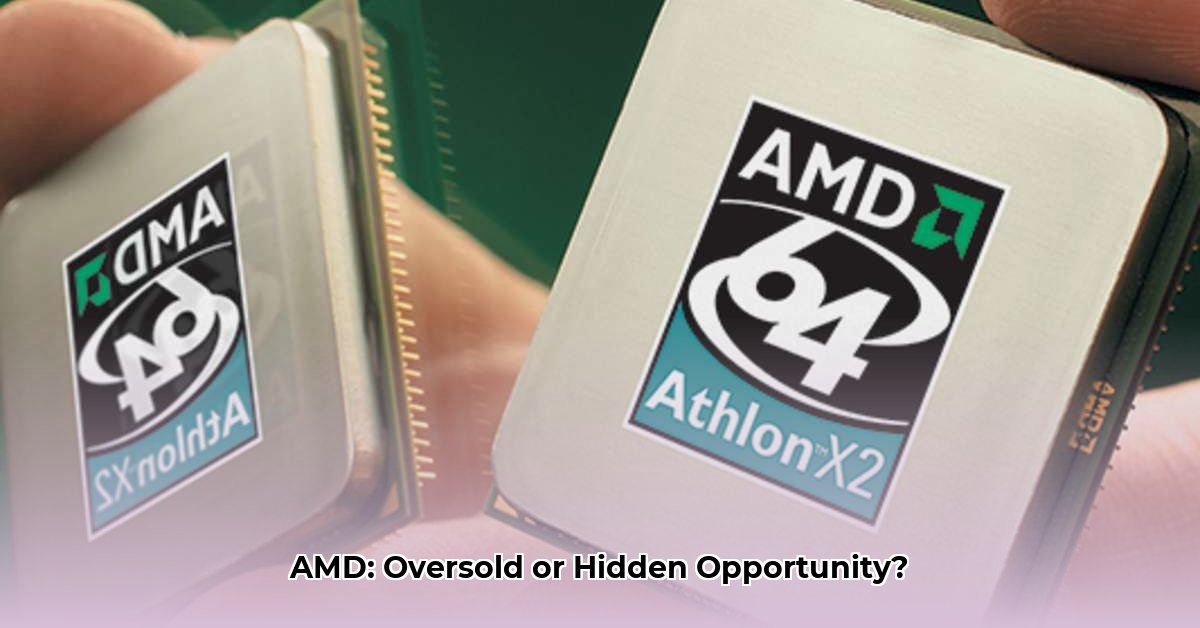
Is AMD stock a bargain, or are investors overreacting to recent market volatility? The rapid expansion of the AI chip market, coupled with AMD's aggressive entry, has created a complex valuation puzzle. This analysis explores the factors influencing AMD's stock price, offering a balanced perspective to inform investment decisions. For further insights into market trends, check out this resource on energy storage stocks.
Is AMD Really Oversold? A Deeper Look
While technical indicators like the Relative Strength Index (RSI) might suggest AMD is oversold (an RSI below 30 often signals a potential buying opportunity), relying solely on such metrics is insufficient. A comprehensive evaluation requires a broader perspective. Think of it like assessing a used car—a low price is enticing, but a thorough inspection is crucial before purchase.
AMD's Recent Performance: A Mixed Bag
AMD's Q4 2024 earnings showcased impressive growth in PC processors, data center chips, and gaming products. This fueled optimism among analysts at firms like Morningstar and Wells Fargo, who predict substantial growth. Morningstar, for example, projects a 17% Compound Annual Growth Rate (CAGR) through 2029. 1 However, these are predictions, not guarantees, and economic uncertainties remain. Further, how much of this growth is sustainable in a changing market is a critical question.
The AI Factor: Nvidia's Shadow
Nvidia's dominance in the AI chip market casts a long shadow. Concerns exist regarding AMD's capacity to compete effectively, particularly in the high-growth AI training segment. White Falcon Capital Management, for instance, has expressed concern about the gap between projected AI revenue and the sector's massive potential. This competitive pressure is a significant risk factor for AMD's stock valuation.
Macroeconomic Considerations
The broader economic landscape critically impacts AMD's valuation. Goldman Sachs and Morgan Stanley cite concerns about potential market overvaluation and the concentrated nature of indices like the S&P 500. This broader market risk significantly influences any company's valuation, including AMD’s. A robust economy favors even fundamentally sound stocks.
Investment Strategies: Short-Term vs. Long-Term
The question of "buy, sell, or hold" depends on individual investment strategies and risk tolerances.
| Investor Type | Short-Term Outlook | Long-Term Outlook |
|---|---|---|
| Individual Investor | Monitor key metrics, earnings reports; consider dollar-cost averaging. | Diversify; consider AMD for long-term growth if AI endeavors succeed. |
| Institutional Investor | Assess long-term AI strategy; mitigate broad market risks. | Explore strategic partnerships to enhance AI capabilities. |
| AMD Management | Address investor concerns regarding AI strategy; invest in R&D. | Secure strategic partnerships to build investor confidence. |
Potential Pitfalls: Identifying Key Risks
Investing in AMD involves inherent risks:
| Risk Factor | Likelihood | Potential Impact | Mitigation Strategies |
|---|---|---|---|
| Intense Nvidia Competition | High | High | Focus on niche AI markets; aggressive R&D strategic partnerships |
| Economic Slowdown | Moderate | High | Diversify investments; build financial safety net |
| Overvalued Stock Price | Moderate | Moderate | Thoroughly analyze financial statements; benchmark against competitors |
| Supply Chain Disruptions | Moderate | Moderate | Diversify supply sources; maintain strategic inventory |
| Regulatory Hurdles | Low | Moderate | Engage with regulatory bodies and industry groups |
How to Evaluate AMD Stock Valuation Considering AI Market Competition
Evaluating AMD's valuation requires a complex approach, extending beyond simple metrics. Disparities in valuation estimates highlight the need for a rigorous analysis of underlying assumptions regarding growth rates, discount rates, and competitive dynamics.
Deconstructing the Valuation
The current valuation debate hinges on differing growth expectations and competitive landscapes. A critical analysis requires comparing AMD's revenue projections, profit margins, cash flow, and debt levels to industry benchmarks. A simple P/E ratio doesn't tell the whole story—future growth expectations significantly influence its interpretation.
Navigating the AI Market
AMD's focus on AI inference faces stiff competition from Nvidia’s dominance in the high-end training market. The size and profitability of the inference market relative to the training market are key uncertainty factors.
Competitive Landscape Analysis
A detailed competitive analysis, incorporating market share, technological advantages, pricing strategies, intellectual property landscapes (patents), and R&D spending, is crucial for a realistic valuation.
Actionable Steps for Investors
- Monitor Financial Reports: Regularly review AMD's quarterly reports and analyst commentary.
- Track Market Trends: Stay informed about broader AI market trends.
- Diversify Investments: Reduce risk by diversifying your portfolio.
The Bottom Line: Informed Decision-Making
Determining whether AMD is oversold requires a thorough analysis of technical indicators, financial performance, the competitive landscape, and broader economic trends. The insights shared here do not constitute financial advice. Always conduct independent research and carefully assess your risk tolerance before making any investment decisions.